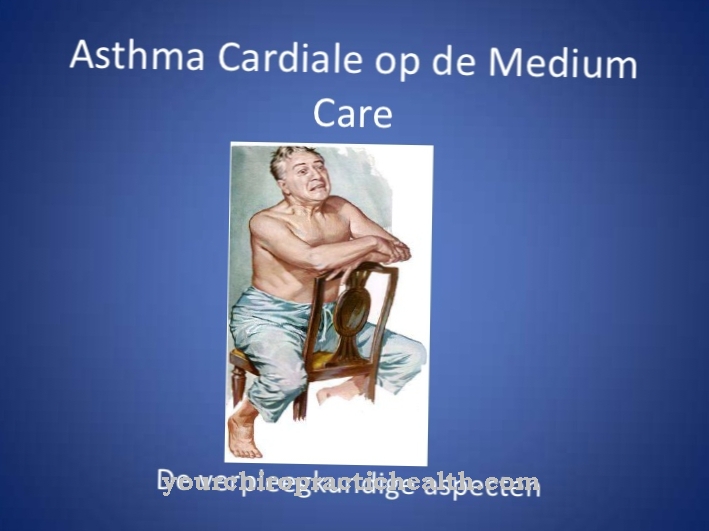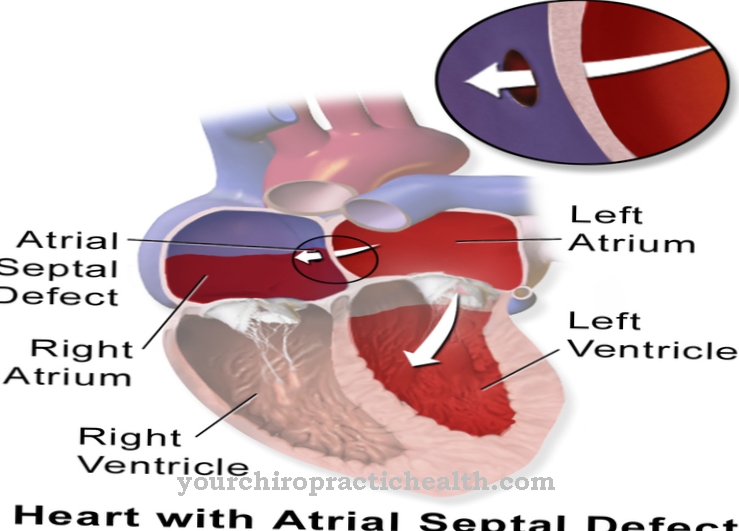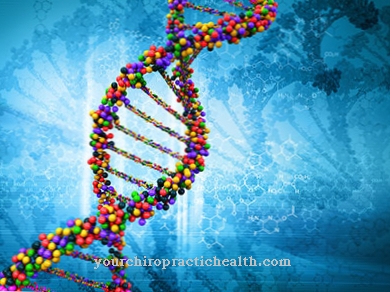A Vertebral joint arthrosis is a wear disease of the spine. Of that too Facet syndrome This disease affects the articular processes ("facets") on each vertebra, through which the vertebrae are connected to one another.
What is vertebral joint arthrosis?

The Vertebral joint arthrosis is characterized by the wear and tear of the small vertebral joints. Since the articular processes have nerve fiber ends that absorb pain stimuli and pass them on to the central nervous system (pain receptors), back pain can occur in vertebral arthrosis.
However, not all arthrosis of the vertebral joints leads to pain. Facet syndrome can affect the entire spine, but in many cases it occurs in the lower lumbar spine. Since it is a disease of wear and tear, arthrosis of the vertebral joints is particularly common and with particularly severe symptoms noticeable in old age.
A combination of vertebral joint arthrosis with a degenerative change in the intervertebral discs or with a so-called spondylolisthesis (vertebral sliding), in which vertebrae shift against each other, is also possible. Vertebral joint arthrosis can also lead to a narrowing of the spinal canal (spinal canal).
causes
The Vertebral joint arthrosis is a disease of wear and tear of the spine caused by the aging process. The intervertebral discs, which are made of cartilage fibers and connect the individual vertebrae, lose fluid with age, so that their height gradually decreases.
With the reduced distance between the vertebral bodies, the vertebral ligaments lose their strength, so that the individual vertebrae can shift and thus the position of the vertebral joints is also changed. The resulting overload of the vertebral joints leads to accelerated wear and tear on the cartilage, which is the basis of vertebral joint arthrosis.
In particular, excessive strain on the spine during work (frequent stooping and heavy lifting) or during sport contribute to vertebral joint osteoarthritis, as do being overweight and, in some cases, rheumatic disease. Herniated discs also lead to a disruption of the interaction between vertebral bodies, vertebral joint and ligaments, which can ultimately trigger vertebral joint arthrosis.
Typical symptoms & signs
- Back pain, especially with exercise
- Vertebral sliding (spondylolisthesis)
- Restrictions in movement of the spine
- Sensory disturbances
Diagnosis & course
The various symptoms of a Vertebral joint arthrosis cannot always be clearly assigned to a spinal disease, but can also be signs of other diseases.
X-rays also show pathological changes in the vertebral joint processes in people who do not feel any symptoms of the disease. Often, sensitive symptoms only appear if the muscles of the trunk are not sufficiently developed.
In the case of arthrosis of the vertebral joints, lumbar vertebral pain that can be attributed to the surface is often not localized. Often an increase in pain can be observed during the day and after exercise. Furthermore, the pain increases when the upper body is bent back, while pain relief can be observed when lying down. The pain radiating to the legs, lower abdomen, groin or buttocks can also be a sign of arthrosis of the vertebral joints.
With imaging methods such as an X-ray examination, computed tomography or magnetic resonance tomography, changes in the bony structures, but also in the spinal canal and in the spinal cord nerves, can be shown and vertebral joint arthrosis diagnosed.
Complications
First and foremost, those affected by vertebral osteoarthritis suffer from very severe pain in the back area. This pain often spreads to the neighboring regions of the body, so that pain can also occur in the pelvis or neck. These occur not only during movement, but often also when you are resting, which can be accompanied by sleep problems.
In the long term, this can lead to depression or irritation in the person concerned. Restrictions in movement and in everyday life can also occur due to illness. The patient's quality of life is significantly reduced by the disease. Furthermore, paralysis or sensory disturbances can occur.
If these are not treated, they can also appear permanently. Due to the numbness, some affected people are also dependent on the help of other people in their everyday life and cannot easily carry out many activities on their own. Vertebral joint arthrosis is usually treated with various therapies and exercises, whereby massages can also alleviate the symptoms. There are no complications. The life expectancy of the patient is also not negatively influenced by the vertebral joint arthrosis.
When should you go to the doctor?
A doctor is required as soon as there are impairments in movement sequences or irregularities in mobility. If the person concerned suffers from back pain, this is a sign of a health disorder. If the symptoms occur after intense physical activity, adequate rest and rest should take place. If there is significant relief or symptom relief within a few minutes, hours or after a restful night's sleep, in most cases no doctor is required.
However, if the restrictions or pain persist or if they increase in intensity, the cause should be clarified. A warning signal and characteristic of the disease is a gradual increase in the symptoms described. Over several weeks or months there is a deterioration in the state of health, malaise or a decrease in physical performance. A doctor should be consulted so that a diagnosis can be made and a treatment plan developed. Sensory disturbances or irregularities in sensitivity should also be examined and treated.
If the daily obligations or accustomed sporting activities can no longer be performed, the help and support of a doctor is recommended. If existing complaints radiate into the area of the hips or legs, action is required. To avoid long-term damage or secondary diseases, a doctor should be consulted.
Treatment & Therapy
The therapy one Vertebral joint arthrosis depends on the symptoms, especially the level of pain, from which the patient is suffering. Since the joint wear cannot be reversed, the treatment of the pain and the restoration of the functionality of the spine are the main focus of the treatment. The mildest suitable treatment method is used.
In most cases, arthrosis of the vertebral joint therefore becomes conservative, i. H. treated without surgery. Only in the case of severe deficits and numbness is usually operated on.
Conservative therapies include B. Physiotherapeutic measures such as gymnastics and massage. Physiotherapy exercises serve to build up the back and abdominal muscles, so that the spine is relieved and strengthened as much as possible. Hydrotherapy, in which water is used to treat symptoms, relies primarily on the temperature stimulus and also on the buoyancy and pressure of the water.
In electrotherapy, finely dosed electrical current is passed through the patient's body. Relaxation exercises can also be helpful. Since physical exercise is one of the most important therapeutic measures for vertebral osteoarthritis, regular exercise such as B. cycling, Nordic walking or backstroke swimming are particularly important, as these forms of activity are back-friendly and back-stabilizing.
Painkillers help temporarily with acute, particularly severe symptoms. In individual cases, wearing a corset can help to stabilize the spine, but permanent use of the corset will tend to weaken the muscles.
The next step in the pain therapy of vertebral joint arthrosis is the so-called facet blockade or facet joint infiltration, in which the pain-inducing vertebral joint is punctured and painkillers are injected into the joint area. A small surgical intervention is carried out in the case of radio frequency lesions, in which the nerves on the vertebral joint are made insensitive under local anesthesia.
The spinal canal can also be surgically expanded to take pressure off the nerve tracts. Spinal fusion (blocking of vertebral bodies) is used to stiffen vertebral bodies in order to stabilize the spine. The vertebral bodies are provided with screws that are firmly connected to one another by means of metal plates or rods in order to prevent painful movements of the vertebral joints in vertebral arthrosis.
You can find your medication here
➔ Medicines for back painprevention
As a preventive measure against Vertebral joint arthrosis Exercise sports such as running (especially Nordic walking) and swimming as well as gymnastics to stabilize the spine are suitable. But even if you already have vertebral joint arthrosis, regular exercise helps to strengthen the muscles around the spine and thus prevent or at least inhibit further progression of the vertebral joint arthrosis.
Aftercare
Vertebral joint arthrosis is caused by wear and tear on the vertebral bodies. The bone tissue breaks down as a result of this wear and tear. The disease is progressive and mostly affects the elderly. Due to its chronic nature, osteoarthritis of the vertebral joint requires follow-up treatment. The symptoms are to be alleviated and the quality of life of the patient optimized.
Overexertion, an existing misalignment of the spine or rheumatic diseases are among the risk factors. During follow-up care, the orthopedic surgeon treats existing complaints. This can weaken or even prevent vertebral joint arthrosis.
Starting treatment early is crucial for a favorable result. The person concerned must ensure that the spine is sufficiently spared. Painkillers reduce the symptoms, and physical therapy exercises also help to alleviate the symptoms.
With regular follow-up care, vertebral wear can be reduced. The specialist adapts the treatment to the individual course of the disease. If you experience any unexpected symptoms of paralysis, numbness or similar neurological symptoms, you should see a doctor immediately.
In severe cases, the doctor will consider surgery. Depending on the severity of the osteoarthritis, there are different approaches, such as nerve obliteration through heat or the use of artificial vertebrae. Surgical spinal stiffening is another option. During the aftercare, the healing process is monitored by a doctor.
You can do that yourself
In the case of severe symptoms, medical treatment of the vertebral joint arthrosis is essential. In addition to its recommendations, however, the patient can do a lot to relieve pain and mobility restrictions, even if age-related wear and tear is not reversible.
On the one hand, the patient can reduce any excess weight. It is not important which diet he chooses, because research shows that all diets are similarly successful if they are really followed consistently. Stimulation current therapy, also known as electro or TENS therapy, can also alleviate the pain and has no side effects. To do this, two to four electrodes are attached to the painful areas of the body, through which the stimulation current is then passed. Since only 80 to 120 Hertz are used, there is only a gentle tingling sensation on the skin, which can, however, mask the pain. The body now releases endorphins that attach to the pain receptors. With regular use, this mechanism can relieve pain.
Orthomolecular medicine also recommends a high daily dose of enzyme for vertebral osteoarthritis. With enzyme therapy lasting several weeks, inflammation and swelling can be reduced sustainably, which at the same time relieves pain and promotes mobility. Massage and relaxation exercises can also help minimize the symptoms of osteoarthritis of the spine. Here the progressive muscle relaxation according to Jacobson as well as Reiki, Yoga and Pilates are recommended.





.jpg)


















.jpg)



